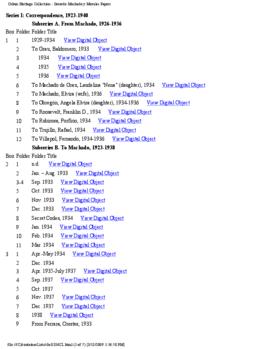Spec's Music Inc. records is comprised of press releases in the form of newspaper and magazine clippings, business records, photographs, store memorabilia, and framed music posters, and plaques acquired during Ann Lieff's tenure.
The following description of material types and context was provided by JC Bourque, the main designer for Spec's merchandising and ad campaigns:
Promotion to Record Labels
These programs were intended to convince the record labels to allocate advertising revenue, known as “co-op” funds, to Spec’s Music rather than the competitors, or at least garner a larger share of the labels’ promotion budgets. Spec’s would commit to a media schedule, and use these materials to show the labels how much coverage they could get for their co-op dollars.The calendars were created to show the various advertising and store promotion themes that would be employed during the upcoming year. For example, Country Music Month would employ a different media mix than Classical Music Month. Knowing this, the labels might coordinate the release of major artists when the media mix was weighted toward that musical genre.
Promotion to Public
Marketing to the public included radio and TV spots, newspaper ads and inserts, in-store signage and theme art, direct mail, in-store sale flyers and other methods. Typically, a theme would be created and used across all platforms used for a particular promotion. The particular mix of media and other methods would vary according to the particulars of each promotion.
Newspaper Ads and Inserts
Spec’s would often place full-color, full page ads on the back covers of the Sunday lifestyle magazine in various major newspapers in Florida and Puerto Rico. Sometimes, for major promotions, multi-page inserts printed on higher-quality paper were inserted into newspapers instead.
Music Genre Art
These artworks were produced by Impossible Images for use in print materials to denote various musical genres.
Store Signage
Several types of in-store signage were used to reinforce the advertising messaging utilized in radio, TV, and print media.
Posters - There were two types of posters produced. Single-sided posters were used on walls and windows. Double-sided posters were hung from the store ceiling grid so they could be seen from any place in the store.
Danglers - These were also hung from the grid. A single line was attached to one corner of the dangler, presenting a diamond-shaped sign that would rotate in the air currents of the ventilation system.
Genre Signage - These were typically mounted on top of the music bins (gondolas) and consisted of the genre descriptor (Country, Jazz, etc.) and a Spec’s logo. These would identify specific locations for the different types of music. These were used in conjunction with large murals, below, that showed customers the general area of their music preferences.
Retrofit Signage - These were developed by Impossible Products to be added to older gondolas that had not been fabricated with slots for the genre signage holders. These were installed between back-to-back gondolas, with different genre inserts on either side.
Sound & Vision Magazine
This was a periodic publication that would showcase popular music and video releases. The music section was named “Sound &”, while the video section, printed upside down relative to the music section, was titled “Vision &”, so ether side could be considered the front page.
Moon Beach TV Spot
This was a “theme” TV spot (as opposed to a “donut”, below) that was intended to increase “top-of-mind-awareness” of the Spec’s brand, and create a shopping preference in the consumer. It was shot completely under ultraviolet light, and all the props, costumes and makeup were decorated with fluorescent materials.
The script, costumes and props were created by JC Bourque of Impossible Images, Inc. The spot was directed and shot by David Schweitzer. The footage was shot on 16mm film and transferred to electronic media for compositing.
The music was composed after the footage was roughed in. Various visual elements, such as the “frizbee” landing were accentuated in the music track. The musician thought JC was nuts when he proposed attempting this.
Behind the Scenes - Moon Beach TV Spot
These are photos of the shoot during production.
“Dominoes” Video TV Spot
This is an example of a “donut” spot introducing Spec’s entry into the video market. The donut would be distributed to the various TV stations, and the “hole” would be filled with promotions for specific video titles, with the visuals and narration supplied by the station. These insert would be different and various stations depending on demographics, time slot and label co-op purchases.
Special Promotions
Various themes, such as “Instant Hits Blitz,” “Mother’s Day Deals,” and “Saving Season” were developed and deployed across most or all of the media and store displays.Music... Serious Business This was a campaign to get prospective employees interested in the retail side of the music industry. I believe these were used at job fairs and other venues where people were looking for careers. The poster was designed similar to a playing card, with the two interlocking aspects of the music industry: the music, and the business.The brochure was a take-away for the prospect and included in-depth information about the business side of the industry.



